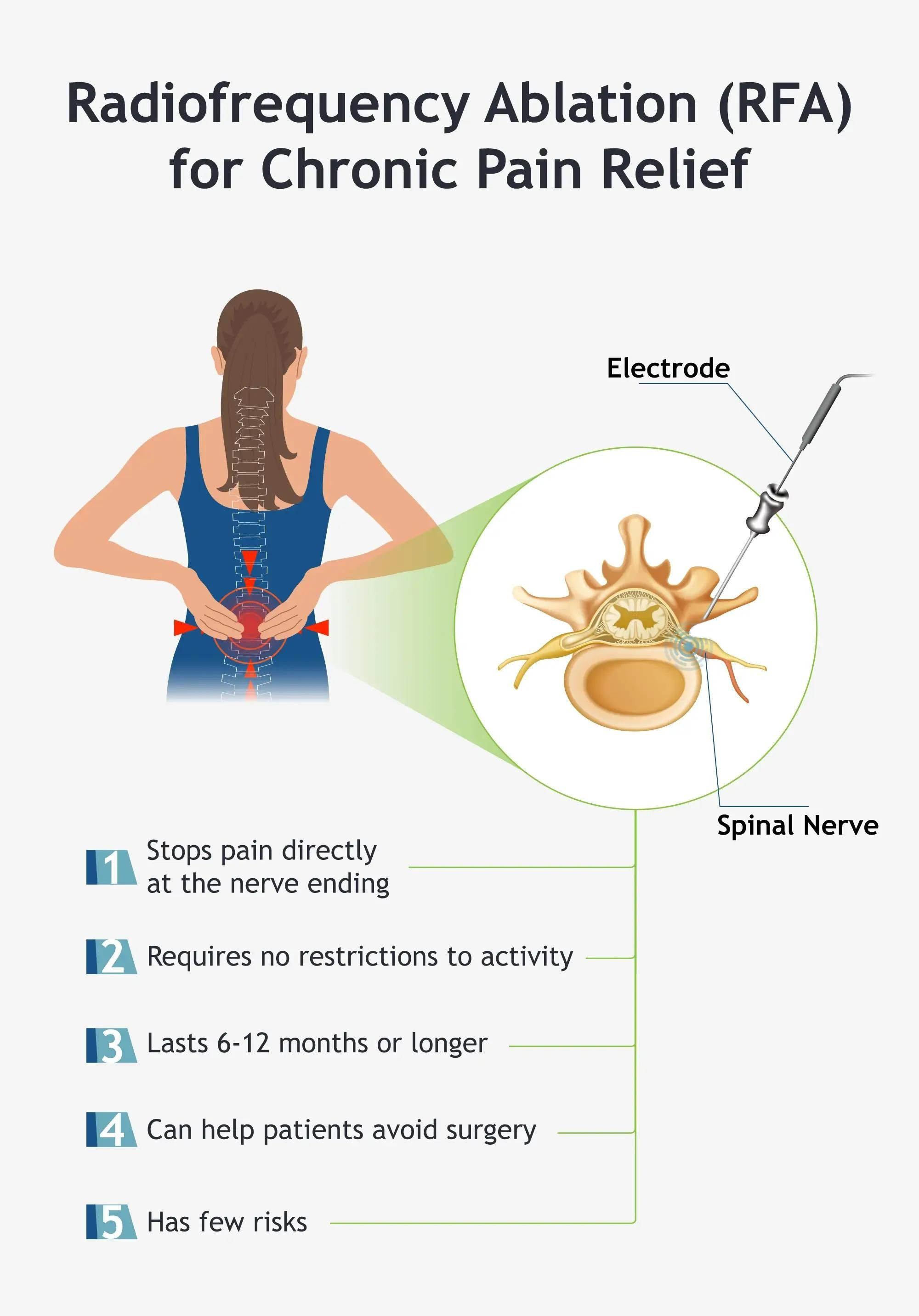Radiofrequency Ablation (RFA)
Download the Cervical Radiofrequency Ablation (RFA) treatment handout
Download the Lumbar Radiofrequency Ablation (RFA) treatment handout
Radiofrequency ablation (RFA) can be a longer-lasting option for patients seeking chronic pain relief when other pain treatments have been unsuccessful. By stopping pain from nerve irritation directly at the source—the nerve ending—radiofrequency ablation is one of the best procedures pain specialists have at their disposal. It requires no restrictions to activity, often lasts months to years, can help patients avoid surgery, and has few risks.
To find out if radiofrequency ablation may help you, call us today at Call Us or contact us online.
What is Radiofrequency Ablation?
Radiofrequency Ablation (RFA) is a minimally invasive procedure done after diagnostic injections have confirmed where the pain is coming from. It can be performed to treat chronic pain in multiple areas of the body.
Most commonly, it is used to address pain in the spine, including the neck and back, but it can be done for specific nerves that go to the major joints, like the knees or even the stomach area, to treat chronic abdominal pain.

What Can I Expect During a Radiofrequency Ablation Procedure?
Radiofrequency ablation is an outpatient procedure.
During radiofrequency ablation, a thin needle is placed in the area of the nerve irritation to be treated. Most commonly, a special injection called a diagnostic block has been done prior, helping the physician determine that the pain is coming from a specific spot.
The area of skin where the needle will be inserted is injected with a numbing medication (local anesthetic). Sometimes, special testing is done to verify that the needle is close to the correct nerve.
Local anesthetic is then injected to numb the nerve area before the needle is heated with thermal energy to a temperature that blocks the pain signals.
Side Effects of Radiofrequency Ablation
Some discomfort for 1-2 weeks after the RFA procedure is normal, as well as temporary numbness at the injection site. The complication rate of radiofrequency ablation is low. Rarely, skin burns, infection or bleeding at the injection site, permanent nerve damage, or worsening pain may occur.
Types of Radiofrequency Ablation
There are several common types of radiofrequency ablation that can be performed:
- Genicular distal saphenous nerve radiofrequency ablation: This radiofrequency ablation procedure treats chronic knee pain, which is especially common as people age. Severe knee pain can greatly limit mobility and impact overall strength, and genicular nerve radiofrequency ablation can reduce knee pain and the risk of these problems.
- Cervical radiofrequency ablation: The first seven vertebrae of the neck make up the cervical spine. Cervical radiofrequency ablation can be used to treat chronic neck pain and a certain type of headache called a cervicogenic headache.
- Thoracic radiofrequency ablation: The upper portion of the back includes twelve vertebrae. Thoracic radiofrequency ablation treats upper and middle back pain that originates from medial nerves near facet joints (the joints connecting the vertebrae).
- Lumbar radiofrequency ablation: The lower portion of the back includes the five lumbar vertebrae. Lumbar radiofrequency ablation treats chronic pain that originates from lumbar medial nerves at these facet joints.
- Sacral radiofrequency ablation: Sacral, or sacroiliac radiofrequency ablation, treats nerve pain at the sacroiliac (SI) joint. Pain in this area can affect the lower back, pelvis, buttocks, and may travel down the leg.
Radiofrequency Ablation FAQs
Radiofrequency ablation remains one of our most effective methods for long-term pain relief for patients. Our board-certified pain specialists can help develop the right treatment plan for you, including RFA if appropriate.
Common questions patients may have about radiofrequency ablation include:
How much does radiofrequency ablation cost?
The cost for radiofrequency ablation will depend on what kind of RFA is being performed, the number of times it is needed, the patient’s health insurance carrier, and location. Medicare covers the cost of radiofrequency ablation if a physician certifies the procedure is necessary.
At Advanced Spine and Pain, we can help answer questions about cost, health insurance, and payment prior to the procedure.
How do I know if radiofrequency ablation is right for me?
Radiofrequency ablation may be the right choice for you to treat chronic pain if you’ve had successful medial nerve blocks in the past. If you’ve had chronic pain despite other treatments like pain medication or physical therapy in the past, RFA may be a great choice.
If you have a bleeding disorder, are pregnant, or have an active infection, RFA may not be recommended.
Our highly qualified pain specialists can help determine the best approach for your situation.
How well does radiofrequency ablation work?
Chronic pain relief—or “therapeutic response”—from radiofrequency ablation can begin as soon as immediately after the procedure or may take up to 4-6 weeks.
This pain relief may last between 6-12 months and, in some cases, even longer.
Repeat ablation may be necessary if the nerve regenerates in the months after the procedure.
Is Radiofrequency Ablation Right for You?
Ready to learn more about radiofrequency ablation and see if it could make a difference for your pain?
Contact us today for expert advice from our team or call us at Call Us .

